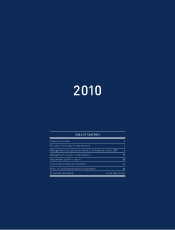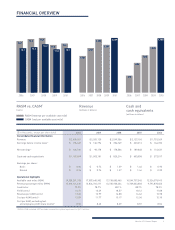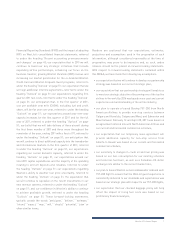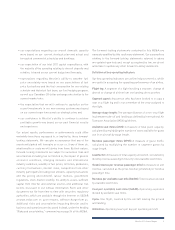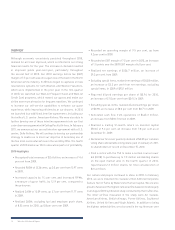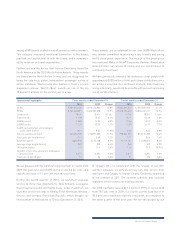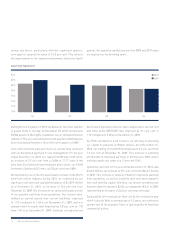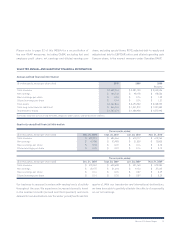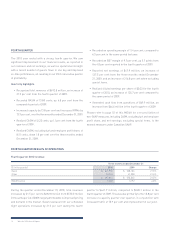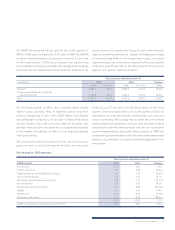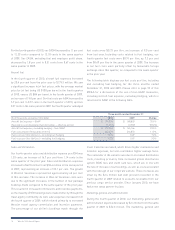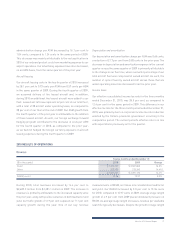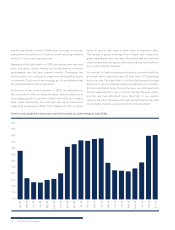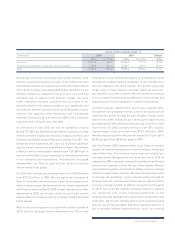Westjet 2010 Annual Report Download - page 11
Download and view the complete annual report
Please find page 11 of the 2010 Westjet annual report below. You can navigate through the pages in the report by either clicking on the pages listed below, or by using the keyword search tool below to find specific information within the annual report.
WestJet 2010 Annual Report 9
• our expectations regarding our overall domestic capacity
were based on our current strategic plan and actual and
forecasted commercial schedules and bookings;
• our expectation of our total 2011 capital expenditures, with
the majority of the spending relating to aircraft deposits and
rotables, is based on our current budget and forecasts;
• expectations regarding WestJet’s ability to weather fuel
price uncertainty were based on our expectations of fuel
price fluctuations and the fuel consumption for our existing
schedule and historical fuel burn, our fuel hedging program,
as well as a Canadian-US dollar exchange rate similar to the
current market rate;
• the expectation that we will continue to capitalize on the
recent investments in our new revenue systems was based
on our current experiences and our strategic plan; and
• our confidence in WestJet’s ability to continue to achieve
profitable growth was based on our past financial results
and experience.
Our actual results, performance or achievements could differ
materially from those expressed in, or implied by, these forward-
looking statements. We can give no assurance that any of the
events anticipated will transpire or occur or, if any of them do,
what benefits or costs we will derive from them. By their nature,
forward-looking statements are subject to numerous risks and
uncertainties including, but not limited to, the impact of general
economic conditions, changing domestic and international
industry conditions, volatility of fuel prices, terrorism, pandemics,
currency fluctuations, interest rates, competition from other
industry participants (including new entrants, capacity fluctuations
and the pricing environment), labour matters, government
regulations, stock-market volatility, the ability to access sufficient
capital from internal and external sources and additional risk
factors discussed in our Annual Information Form and other
documents we file from time to time with securities regulatory
authorities, which are available through the Internet on SEDAR
at www.sedar.com or, upon request, without charge from us.
Additional risks and uncertainties impacting WestJet and its
business and operations are discussed in detail, under the heading
“Risks and uncertainties,” commencing on page 34 of this MD&A.
The forward-looking statements contained in this MD&A are
expressly qualified by this cautionary statement. Our assumptions
relating to the forward-looking statements referred to above
are updated quarterly and, except as required by law, we do not
undertake to update any other forward-looking statements.
Definition of key operating indicators
Our key operating indicators are airline industry metrics, which
are useful in assessing the operating performance of an airline.
Flight leg: A segment of a flight involving a stopover, change of
aircraft or change of airline from one landing site to another.
Segment guest: Any person who has been booked to occupy a
seat on a flight leg and is not a member of the crew assigned to
the flight.
Average stage length: The average distance of a non-stop flight
leg between take-off and landing as defined by International Air
Transport Association (IATA) guidelines.
Available seat miles (ASM): A measure of total guest capacity,
calculated by multiplying the number of seats available for guest
use in an aircraft by stage length.
Revenue passenger miles (RPM): A measure of guest traffic,
calculated by multiplying the number of segment guests by
stage length.
Load factor: A measure of total capacity utilization, calculated by
dividing revenue passenger miles by total available seat miles.
Yield (revenue per revenue passenger mile): A measure of unit
revenue, calculated as the gross revenue generated per revenue
passenger mile.
Revenue per available seat mile (RASM): Total revenues divided
by available seat miles.
Cost per available seat mile (CASM): Operating expenses
divided by available seat miles.
Cycle: One flight, counted by the aircraft leaving the ground
and landing.
Utilization: Operating hours per day per operating aircraft.



